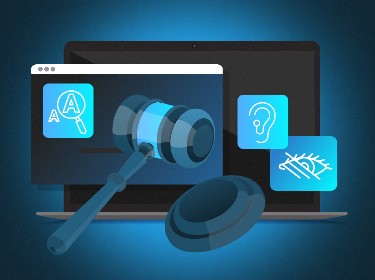Multimillion-dollar fines and site closure. That’s what can lie in wait for you if your website does not meet the accessibility laws and standards.
What does web accessibility mean? The web accessibility of a particular site relates to how its interface is adapted for use by people with disabilities. This fundamental principle is set out by the W3C organization, which developed the Web Content Accessibility Guidelines (WCAG) — the basis of legislative norms in many countries.
Some users of your site may have a visual impairment or some kind of restriction with regard to physical movement. They might only be able to use the keyboard and screen reader to navigate the site, so if the interface of your web pages does not allow them to do this, unfortunately, they will not be able to use your site at all.
Other website visitors may have fine motor problems, which can make it difficult for them to use touch devices. This means that if your site has clickable elements that are too close to each other, people with these impairments will likewise be prevented from using your site.
In short, a website can be called accessible if anyone can use it. Site owners need to ensure they comply with the EU Web Accessibility Directive, as this determines the local laws in many European countries. Let’s dive into the details.
How important is web accessibility in the EU?
According to statistics, 5% of the EU population does not have the opportunity to visit and use internet resources due to physical disabilities. This equates to about 22,500,000 people who suffer from this kind of discrimination. These people are also your potential customers, but they cannot use your services or buy your product because you did not provide them with an accessible website or mobile application.
This explains why in several countries, among them the UK, USA, and EU states, web resource accessibility standards are formalized in the shape of specific legislative norms. This would be much more costly than taking care in advance to ensure that the site meets all the necessary accessibility standards.
Therefore, before starting to develop a site, it is important to understand the nature of the standards with which your website must specifically comply.
What is the EU Web Accessibility Directive?
![]()
The EU Web Accessibility Directive was adopted in 2016. In a nutshell, it requires all government websites operating in the EU to implement and maintain a single set of accessibility standards — WCAG 2.0, to be exact. In turn, websites that do not comply with the directive run the risk of penalties.
The Web Accessibility Directive only applied to public sector bodies, with EU member states required to extend it to national law by 2018. The aim was to make sure all public sector organizations were accessible to the tens of millions of people with disabilities in the EU.
The Directive gave each member state a deadline of 23 September 2018 for national legislation. Each country is currently responsible for complying with its relevant national laws.
The deadlines for the Web Accessibility Directive were:
- all sites created before September 23, 2018 to be available to all by September 2019
- sites that appeared after September 2018 to be available by September 23, 2020
- mobile applications to be available by June 23, 2021
Since the member states must file the first monitoring report with the Commission as early as December 22, 2021, it won’t yet be clear how far the sites are complying.
The authorities that fall under this Directive comprise public sector bodies, as we mentioned above. In particular, it covers government websites such as:
- state, regional, and local authorities
- bodies governed by public law and financed through a public contract
- associations that are not industrial or commercial.
There are some exceptions to the above, applying to schools, non-governmental organizations, and other institutions which don’t expressly provide services to people with disabilities. However, any state in the EU is empowered to expand the scope of the directive to include new branches.
Let’s now take a look at the peculiarities of compliance with the Directive by representatives of the private sector.
A simple checklist of WCAG 2.0 requirements that will help you remediate your website
What about web accessibility laws for the private sector?
Currently, the Web Accessibility Directive (2016/2102) does not apply to private sector entities. The main sphere of its activity is government organizations which are represented in the digital world.
However, in April 2019 another directive, 2019/882 (the European Accessibility Act), came into force. This deals with policies to optimize websites for the sale of goods in the EU, some of which may be intended for people with disabilities. For this reason, WCAG compliance may also be required for some sites from the private sector (the law is expected to enter into force on 28 June 2022).
This means that by the end of June 2022, owners of websites whose users include people with disabilities will need to reconsider their usability and, if necessary, adapt the interfaces for all population groups. Otherwise, the site owners may face penalties.
Other EU web accessibility laws
In the territory of the EU, depending on the country, additional or local laws of web accessibility may apply.
For example, in addition to the Web Accessibility Directive, which contains general rules for the user interfaces of websites and applications, the European Union has adopted the following legislative provisions:
- The European Electronic Communications Code, containing the rules for providing access to affordable communications services
- The AVMSD Directive, responsible for the audio accessibility of media (television and video) for people with hearing impairments
- eIDAS Regulation, stating that products and services should be available to consumers regardless of the need for an electronic signature
All of the above laws, together with the European standard EN 301 549 and European Accessibility Act, form a set of web accessibility requirements for the services and goods provided, including on the internet.
Some countries may have their own laws in addition to those adopted throughout the EU. Therefore, before creating your own website or scrutinizing an existing one, it is important to check its compliance not just with the Directive but also with local regulations. Only then you can be sure that your website is operating legally and that you will not face fines.
Below we highlight the local laws that guarantee web accessibility:
- Act on Equal Opportunities for Disabled Persons (2002)
- Law No. 2005-102 (2005)
- Stanca Act (2004)
- WZG (2016)
- Article 9 of the UNO-BRK (EDI 2018b) (2018)
- Web Accessibility Initiative (WAI) (2013)
Most of the laws on web accessibility around the world are based on the same WCAG standards and lawsuits in EU countries can be hugely expensive.
By failing to take into account people with disabilities when developing a website, a business not only loses a significant number of potential users but also breaks the law in respect to the global market.
Local web accessibility laws in some European countries
![]()
On top of the above Directive, additional laws may apply in individual European or EU member states. We will now look into this more closely.
Web accessibility in Germany
In 2002, Germany adopted its own Law on Equal Opportunities for People with Disabilities. It guarantees unrestricted access to electronic information provided by state organizations and their partner agencies for all groups of people, including people with disabilities.
This law is also called the Barrier-Free Information Technology Ordinance and is abbreviated as BITV. Legal compliance is determined through BITV testing, which is based on WCAG (originally version 1.0, soon to be updated to version 2.1 standards). Non-government sites that adhere to these policies are encouraged to also align themselves with these standards.
Web accessibility in France
In France, Law No. 2005-102 has been in force since 2005. It describes the rights of people with disabilities and, in particular, certain requirements for the accessibility (for people with disabilities) of services provided by public organizations. The time frame within which organizations can fix their websites is two or three years, depending on the location. Therefore, by May 2022 all public sector sites must comply with the RGAA standard based on WCAG 2.0. Unit testing is performed to verify compliance.
Web accessibility in Italy
In Italy, the Regulation on Supporting Access to Information Technology for Persons with Disabilities has been in force since 2004. Also referred to as the “Stanca Act”, it clearly describes the rights of people with disabilities, as related in particular to their Constitution-defined right to unhindered access to web resources. The Act’s requirements are based on WCAG 1.0 standards. The law only applies to websites for government agencies and public organizations and does not apply to the private sector.
Web accessibility in Austria
Austria has a Web Accessibility Act, or WZG for short, which applies to websites and mobile applications of government agencies. It is based on the standards described in WCAG 2.1, as well as in EN 301 549 V2.1.2, and has been in effect since 2018. These policies do not apply to the private sector.
Web accessibility in Switzerland
In Switzerland, Article 8, Paragraph 2 of the Federal Constitution requires that people with a physical, mental or psychological disability are not subject to discrimination (Swiss Confederation 2018). The Disability Equality Act obliges the community and licensed companies to take measures to prevent, reduce or eliminate discrimination (BehiG 2017). The guarantee of equal access to information and services for the public is explicitly stated in Article 9 of the UNO-BRK (EDI 2018b).
Web accessibility in Norway
The Web Accessibility Initiative (WAI) has been operating in Norway since 2013. It regulates the provision of universal design solutions in the field of information and communication technologies. Universal design implies that a website can be used by everyone, regardless of disability. The rules apply to websites intended for the public and also to the education and training sector.
Check out how web accessibility is regulated in Canada
Fines that websites may face
![]()
Each country has its own requirements for compliance with web accessibility. This means that before you start evaluating your website for web accessibility, you need to check the legislation of the country in which it will operate.
As for the fines, they can vary depending on the cumulative number of violations. In addition, your site may be closed altogether until you have ensured full compliance with the policies of a particular law. Therefore, it is important to know how to prevent these difficulties. To do so, you will need to coordinate all aspects of compliance with the development team that is responsible for maintaining your website.
To take an example from the United States, a precedent was established by the case of the National Federation of the Blind against Target, in connection with the inaccessibility for blind users of the company’s website. The company agreed to settle the lawsuit by optimizing the website and paying $6 million as a result of the class action and another $3.7 million in attorney fees.
A similar case arose in 2018 when Amazon faced a lawsuit over accessibility barriers for blind or visually impaired users. In particular, this marketplace could not be used in conjunction with screen readers and refreshable braille displays. Despite the fact that the lawsuit ended harmoniously, Amazon had to make some fixes to the website interface.
Avanti Hotel in Palm Springs also faced a lawsuit. The plaintiff argued that the hotel’s website could not be used by people with hearing or vision impairments. The hotel had to pay the plaintiff $8,000-$20,000 in damages.
How does the EU conduct compliance monitoring?
EU countries should regularly update their reports on accessibility, explain the risks of a violation of the Directive, describe the available feedback methods for reporting violations of the Directive’s requirements, and give due consideration to methods of monitoring and reporting.
Essentially, the monitoring methods for each EU member state are their own. As for the reporting, which should be sent to the EU Commission, the first requirement is limited to the deadline of December 23, 2021. Re-reporting will be required after three years.
How to check if your website complies with the law
Since all the laws of web accessibility that are in force in the EU are based on WCAG 2.0, it makes sense to focus on this standard. There are four principles of web accessibility in the standard:
- perceivable: people should be able to access content via the faculties that are available to them. For example, people with visual impairments should be able to hear content
- operable: people should be able to interact with the web application or content in any environment
- understandable: content and user interface should be understandable to all the people who use them
- robust: any solution provided must be widely available for use on a variety of platforms or systems. This requirement prevents the problem of solutions being delivered that not everyone can use because the software fails to comply with certain regulations
Of course, websites are not expected to meet every single one of the European Web Accessibility Directive requirements. For example, a screen reader is expected to transmit pages to people who need it, and not every website will provide an audio version of its content. However, at the same time, the website is expected to provide pages that can be read with a conventional screen reader.
After your site has been created, you need to check if the resource matches the declared accessibility status. For example, you should test (with manual and automated testing) how the following components comply with the Directive:
- page structure
- headers
- text
- links
- images, audio, and video with subtitles
- documents (PDFs, Word documents, spreadsheets, etc.)
- online forms
It should be pointed out straight away that you need to start testing a website by checking its key pages with common HTML and CSS validators. Because even if your site was built with basic accessibility standards in mind, it can hardly be considered a quality product if it does not even meet the most basic specifications.
There are tools provided by the W3C consortium for validation — W3C HTML validator and W3C CSS validator. They will help you to check the markup and CSS code. While this can be done automatically, the results must then be interpreted by web accessibility professionals.
Find out which fonts are considered accessible and are WCAG-compliant
Conclusion
The purpose of the web accessibility laws described above is to reduce the number of barriers for people with special needs who use modern technology. In addition, the EU seeks to establish clear requirements for companies creating technologies based on WCAG standards, and make them mandatory for state organizations — for now — and in the future possibly for private ones too.
A website owner should carefully study the legal provisions that are in force in their own country and check their websites for compliance with them. If you need help picking through a variety of laws and requirements — perhaps you are not sure that you can bring your website to full accessibility on your own — you can delegate the task to web accessibility consultants.
Professional web accessibility audit services providers will analyze your business case, test your website, report issues and fix them, redesign inappropriate UI components, and re-audit to verify WCAG compliance.
Don’t wait for your site to be judged by the authorities. Instead, take care of your customers and business today.




